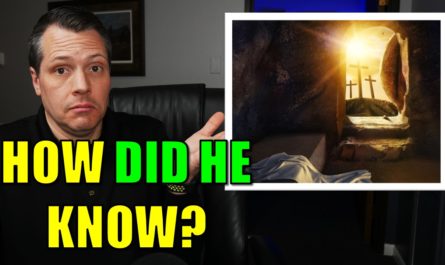In our previous article, we looked at the long list of people who were eyewitnesses to the resurrection of Jesus. But the fact that we have all these witnesses brings up another question: Is it possible that they were merely hallucinating? Maybe these folks wanted so badly for Jesus to rise that they saw Him when He wasn’t really there.
Is this a possibility? In a word, no. I am going to give you eight reasons why we can know that these Jesus-sightings were not hallucinations.
1. Hallucinations are abnormal
When a person hallucinates, something is not right. This is not something we expect in a normal occurrence, especially with so many people in such a short amount of time. Hallucinations happen to select people for certain reasons.
According to the National Institutes of Health, conditions that cause hallucinations include such abnormal circumstances as psychosis, delirium, dementia, seizures, migraines, sleep disturbances, drugs, and tumors.[i]
The point is that normal people do not just go around hallucinating—especially about the same thing at the same time. If you hallucinate, there is a problem. It is abnormal. There is no reason to think that hallucinations are common enough to account for the hundreds of sightings of the resurrected Jesus.
2. Hallucinations are individual events
When people do hallucinate, they do not do it in groups. Hallucinations occur in the mind, and one’s mind is inaccessible to others. They are like dreams. We may dream about other people, but the other person does not remember the dream. We have to explain it to them. However, we have hundreds of people all saying the same thing about the resurrected Jesus. These were no hallucinations.
3. Each situation was different
If sightings of the resurrected Jesus were simply hallucinations, you would think that every experience would have been the same. This, however, was not the case.
4. They happened at different times
If mass hallucinations were responsible for the Jesus-sightings, how would we account for the various times they happened? Jesus appeared at the tomb, in the locked room, on the road to Emmaus, and who knows where else.
5. No one expected Jesus to rise
One argument against a risen Jesus is that His followers wanted it so badly that they imagined it. However, it seems that they were clueless about the idea of a resurrection, even though Jesus had repeatedly prophesied it. They simply were not expecting it, so they did not imagine it happening.
6. Disbelievers became believers
James, the brother of Jesus, did not believe. After all, who would believe that his brother was God incarnate? Yet when he saw the resurrected Christ, he believed, and it transformed his life.
Then there was Paul. Not only did he not believe in the resurrection before he met Jesus, he did not want it to be true. But there he was, ambushed outside of Damascus, facing the risen Christ.
7. You can’t touch a hallucination
I have never experienced a hallucination, but if I did, I assume that I would not be able to touch whatever I was seeing. However, Jesus had a real, physical body. One that people could touch.
Now as they said these things, Jesus Himself stood in the midst of them, and said to them, “Peace to you.” But they were terrified and frightened, and supposed they had seen a spirit. And He said to them, “Why are you troubled? And why do doubts arise in your hearts? Behold My hands and My feet, that it is I Myself. Handle Me and see, for a spirit does not have flesh and bones as you see I have.” When He had said this, He showed them His hands and His feet. (Luke 24:36-40)
And as they went to tell His disciples, behold, Jesus met them, saying, “Rejoice!” So they came and held Him by the feet and worshiped Him. (Matthew 28:9)
Then He said to Thomas, “Reach your finger here, and look at My hands; and reach your hand here, and put it into My side. Do not be unbelieving, but believing.” And Thomas answered and said to Him, “My Lord and my God!” (John 20:27-28)
This sure convinced Thomas, who at first did not believe.
8. What about the empty tomb?
If the appearances of Jesus were nothing more than hallucinations, how do you explain the empty tomb and the graveclothes sans body?
All someone would have to do is produce a body, and PRESTO! No more Christianity. But, for 2,000 years, no body has been found.
Let’s finish by looking at one of the post-resurrection appearances of Jesus. The disciples had spent the night fishing, to no avail. Jesus showed up on the shore, commanded them to try casting their nets on the other side of the boat, and observed as they hauled in a massive catch. When the disciples finished dragging their nets to the shore, they noticed Jesus cooking breakfast over a fire.
Then, as soon as they had come to land, they saw a fire of coals there, and fish laid on it, and bread. Jesus said to them, “Bring some of the fish which you have just caught.” Simon Peter went up and dragged the net to land, full of large fish, one hundred and fifty-three; and although there were so many, the net was not broken. Jesus said to them, “Come and eat breakfast.” Yet none of the disciples dared ask Him, “Who are You?”—knowing that it was the Lord. Jesus then came and took the bread and gave it to them, and likewise the fish. This is now the third time Jesus showed Himself to His disciples after He was raised from the dead. (John 21:9-14)
My question is this: How does a hallucination cook breakfast? It seems to me that it would be difficult to eat something a hallucination made.
But there is something else to see here. Why did John point out that it was the third time Jesus appeared to them?
He may have stressed this to prove that they were not hallucinating. After all, the Law required two or three witnesses to make a case (Deut. 19:15). Jesus appeared to them three times up to that point, proving that they were actually seeing Him. If you see something strange once, you might later wonder if you really saw it. But after three times, you are certain.
All things considered, I think we have enough evidence to prove that the sightings of the resurrected Jesus were not hallucinations. While we have hundreds of eyewitnesses, there are zero respectable witnesses who claim to have seen the dead body of Jesus after His resurrection.
[i] https://www.ncbi.nlm.nih.gov/pmc/articles/PMC2660156/



